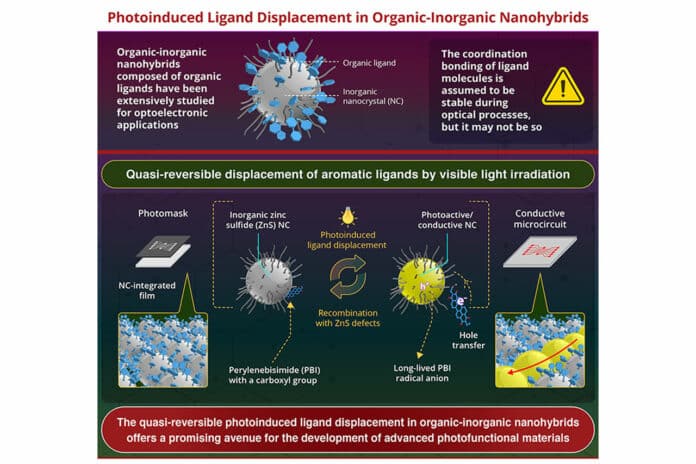In optoelectronic materials, including solar cells, photocatalysis, and photon upconversion, extensive research has been conducted on organic-inorganic nanohybrids using semiconductor nanocrystals (NCs) coordinated with aromatic organic molecules. In these materials, it is typically believed that the coordination bonds of the ligand molecules will remain stable throughout optical processes. This presumption is only sometimes true, though.
Researchers from Ritsumeikan University, Japan demonstrate that the coordination bonds between ligand molecules and NCs by carboxyl groups are displaced quasi-reversibly by light irradiation using zinc sulfide (ZnS) NCs coordinated with perylenebisimide (PBI) as a model system. This is the first time researchers demonstrated the quasi-reversible displacement of ligands in organic-inorganic nanohybrids by exposing them to visible light.
As a result, they observed photoinducible displacement that could lead to the development of advanced photo-functional materials with greater functionality.
Researchers made a breakthrough by demonstrating the quasi-reversible displacement of organic ligands on the surface of nanocrystals. The results suggest that the coordination bond between perylene bisimide with a carboxyl group (PBI) and inorganic zinc sulfide (ZnS) nanocrystals can be reversibly displaced when exposed to visible light.
The findings offer a new view of the common belief that the organic ligands are anchored to the surface of the nanocrystals.
Professor Yoichi Kobayashi from Ritsumeikan University, Japan, said, “We explored the ligand properties of organic-inorganic nanohybrid systems by using perylene bisimide with a carboxyl group (PBI)-coordinated zinc sulfide (ZnS) NCs (PBI–ZnS) as a model system. Our findings provide the first example of photoinduced displacement of aromatic ligands with semiconductor nanocrystals.”
To comprehend the peculiar photoinducible properties of the material, the researchers conducted theoretical analysis and experimental investigations in their study. The researchers first performed calculations using density functional theory to understand the structure and orbitals of PBI-ZnS ([PBI-Zn25S31]-) in both its ground and first excited states. Next, they used an ultrafast laser to excite the material using time-resolved impulsive stimulated Raman spectroscopy. This aided in their analysis of the accompanying Raman spectrum, which showed the characteristics of PBI-ZnS’s excited state.
According to experimental findings and mathematical analysis, one electron is excited from the PBI molecule upon photoexcitation, and the accompanying “hole” (the vacancy created by the lack of the electron) quickly transfers from the aromatic ligand (PBI) to ZnS. This causes a long-lasting, negatively-charged PBI ion to be ejected from the ZnS nanocrystal’s surface.
However, the displaced ligands eventually recombine with the ZnS nanocrystal’s surface flaws, causing a quasi-reversible photoinduced displacement of coordinated PBI. Notably, the dynamic behavior of coordinated ligand molecules in this work differs from that seen for conventional photoinduced charge transfer processes, where the hole often stays on the donor molecule to allow for rapid recombination with the electron.
Prof. Kobayashi says, “The precise understanding of ligand-nanocrystal interaction is important for fundamental nanoscience and developing advanced photo functional materials using nanomaterials. These include photocatalysts for decomposing persistent chemicals using visible light and photoconductive microcircuit patterning for wearable devices.”
“Indeed, the results of this study present a promising avenue for enhancing the tunability and functionality of inorganic materials with aromatic molecules. This, in turn, could significantly impact the field of fundamental nanoscience and photochemistry in the coming times.”
Journal Reference:
- Daisuke Yoshioka, Yusuke Yoneda, I-Ya Chang, Hikaru Kuramochi et al. Quasi-Reversible Photoinduced Displacement of Aromatic Ligands from Semiconductor Nanocrystals. ACS Nano. DOI: 10.1021/acsnano.2c12578
